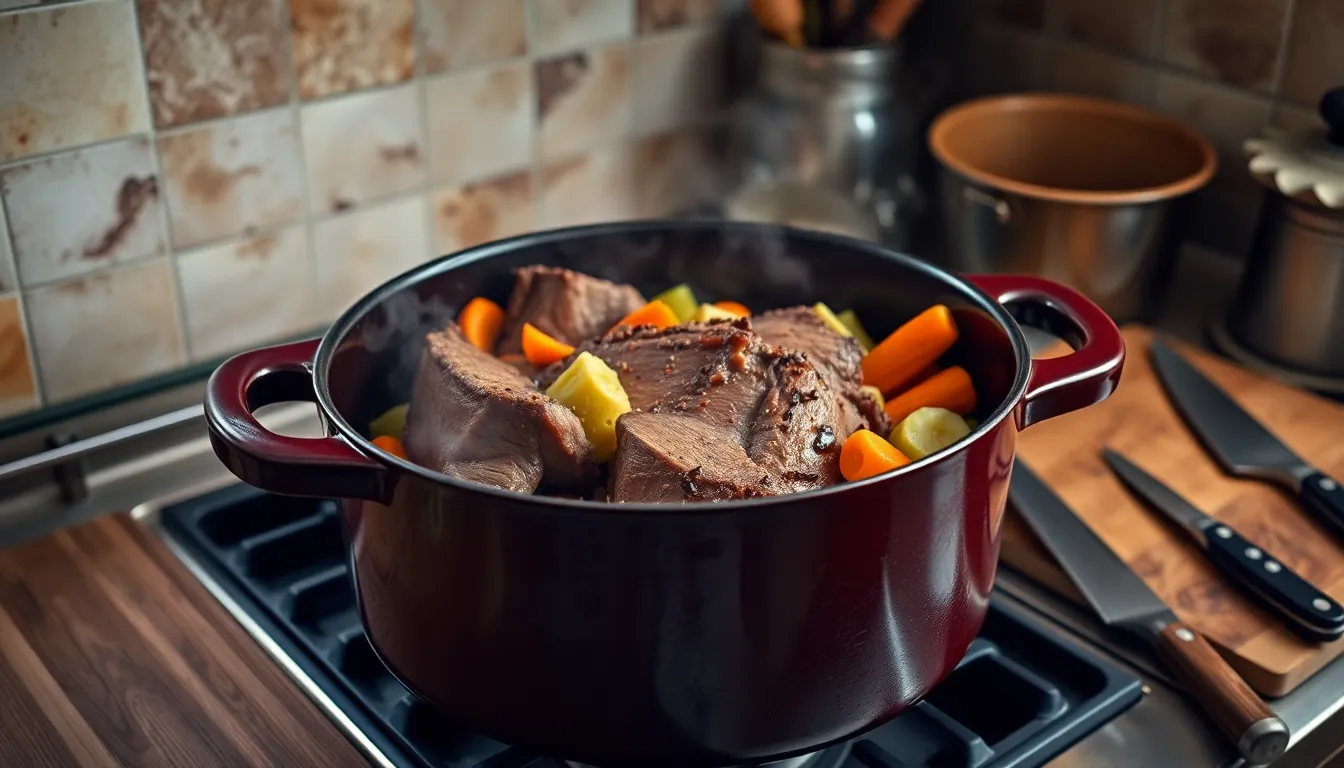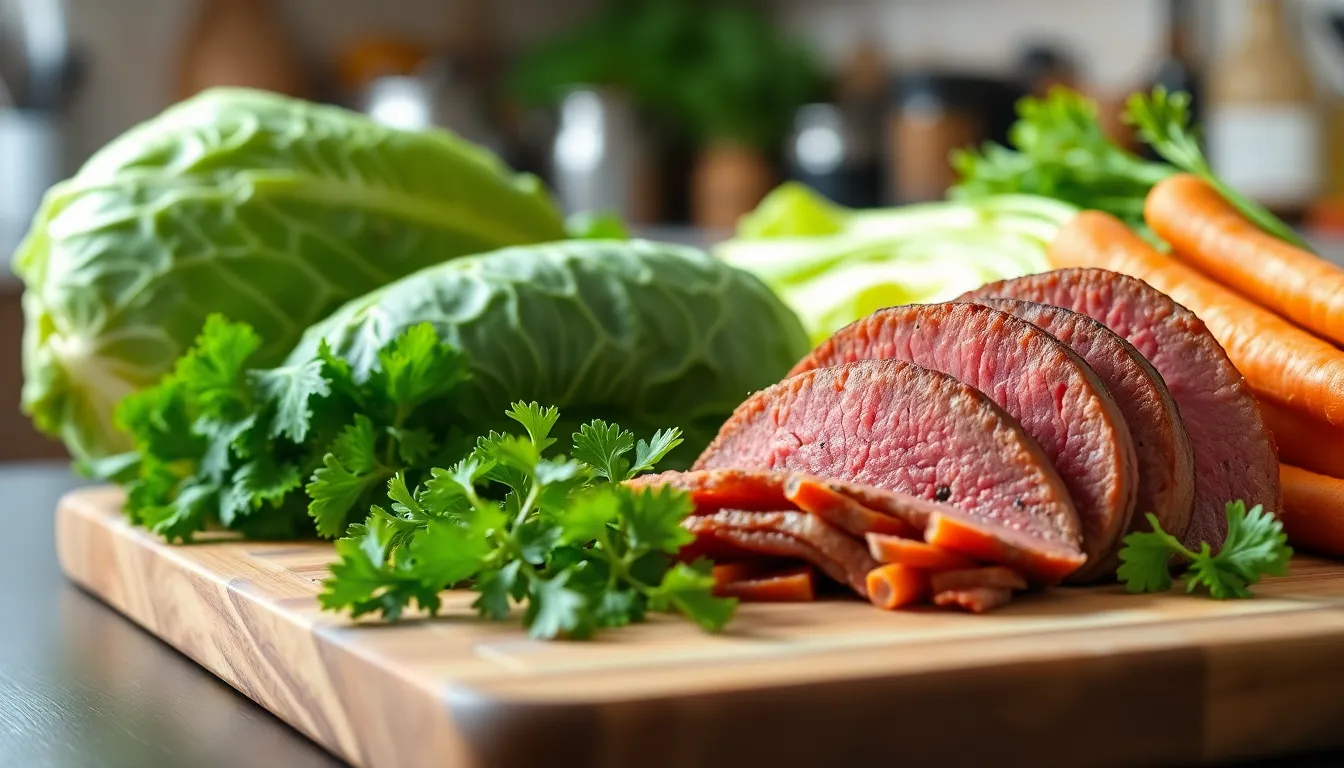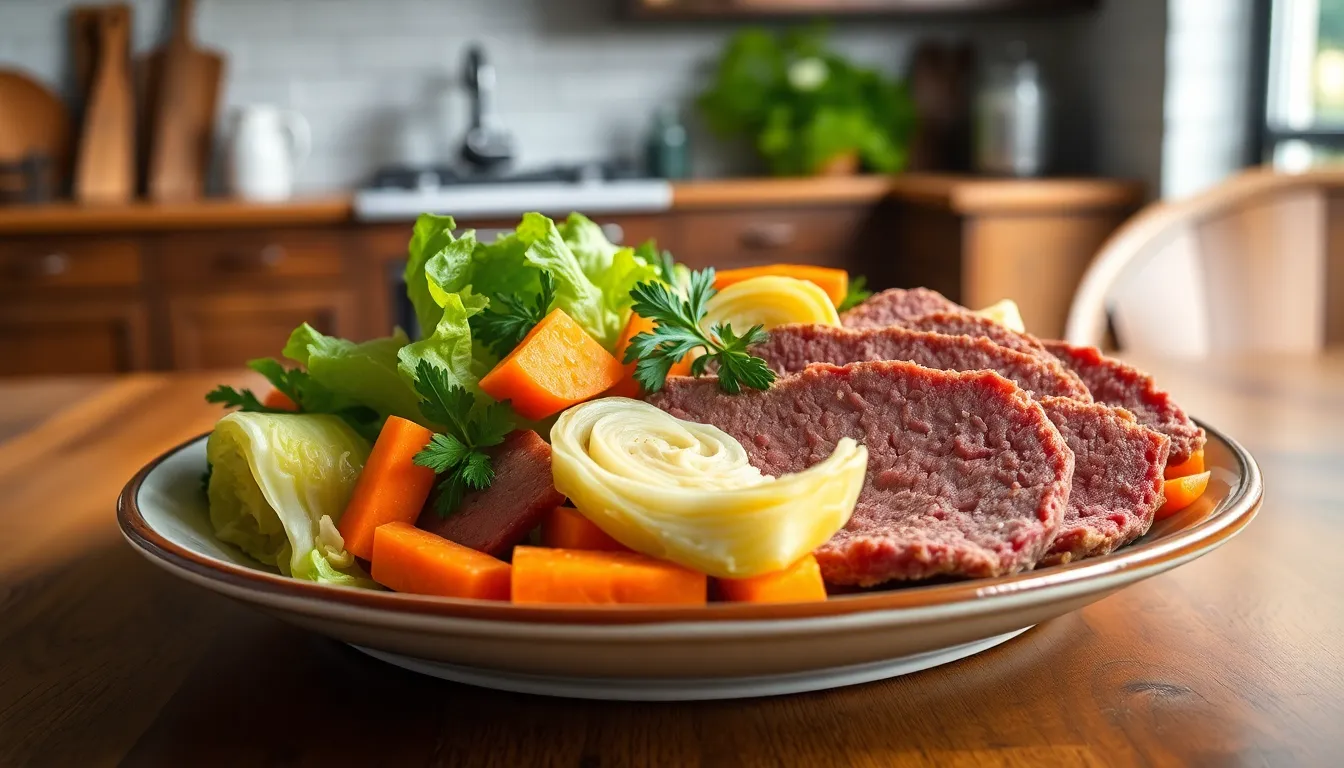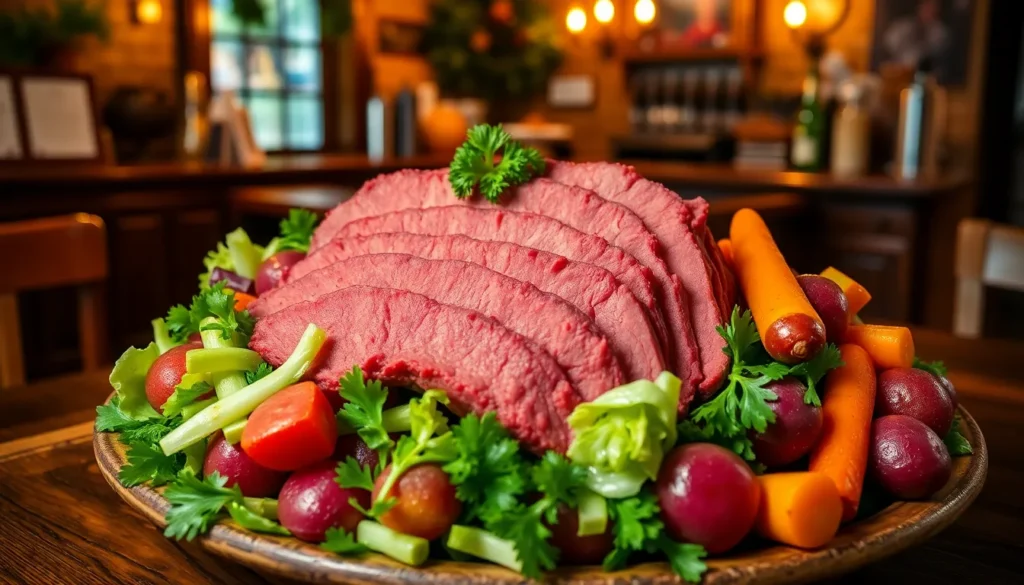Corned beef and cabbage transforms your kitchen into an authentic Irish pub with its rich aromas and hearty flavors. This beloved comfort dish has warmed hearts for generations and earned its place as the ultimate St. Patrick’s Day tradition. We’re sharing our foolproof recipe that delivers tender, perfectly seasoned corned beef paired with sweet cabbage and creamy potatoes.
There’s something magical about slow-cooking corned beef until it practically falls apart at the touch of your fork. The salty-sweet brine creates an incredible depth of flavor that penetrates every fiber of the meat. When combined with fresh cabbage that soaks up all those delicious cooking juices, you get a meal that’s both satisfying and soul-warming.
Our step-by-step approach ensures you’ll achieve restaurant-quality results every single time. Whether you’re celebrating Irish heritage or simply craving comfort food that hits the spot, this one-pot wonder delivers maximum flavor with minimal fuss.
Ingredients
We’ve carefully selected each ingredient to ensure our corned beef and cabbage delivers maximum flavor and tenderness. These components work together to create the perfect balance of savory meat and fresh vegetables.
For the Corned Beef
- 3 to 4 pound corned beef brisket with spice packet
- 8 cups water (or enough to cover the meat)
- 2 bay leaves
- 1 large onion, quartered
- 4 garlic cloves, smashed
- 2 tablespoons brown sugar
- 1 tablespoon whole peppercorns
- 1 teaspoon coriander seeds
For the Vegetables
- 1 large head green cabbage, cut into wedges
- 2 pounds small red potatoes, halved
- 1 pound carrots, peeled and cut into 3-inch pieces
- 1 large onion, cut into thick slices
- 3 celery stalks, cut into 3-inch pieces
- 2 tablespoons fresh parsley, chopped (for garnish)
Optional Seasonings and Spices
- 1 teaspoon mustard seeds
- 1 teaspoon fennel seeds
- 2 whole cloves
- 1 cinnamon stick
- 1 tablespoon apple cider vinegar
- 2 tablespoons butter
- Salt and black pepper to taste
- Prepared horseradish for serving
- Dijon mustard for serving
Equipment Needed

Success with corned beef and cabbage depends on having the right tools for the job. We’ve tested various cooking methods and equipment combinations to ensure our recipe delivers restaurant-quality results every time.
Large Stock Pot or Dutch Oven
Our top recommendation is a 6-quart or larger Dutch oven for stovetop cooking. This size accommodates a 3 to 4 pound brisket while providing enough room for all vegetables without overcrowding. The heavy bottom ensures even heat distribution and prevents scorching during the long cooking process.
Slow Cooker Alternative
For hands-off cooking, we recommend a 6-quart or larger slow cooker. This method delivers incredibly tender results and allows you to start the dish in the morning for evening dining. The extended cooking time at low temperature breaks down tough fibers beautifully.
Essential Cutting Tools
Sharp knives make vegetable preparation efficient and safe. We use a chef’s knife for slicing cabbage into wedges and cutting carrots into uniform pieces. A sturdy cutting board provides stable workspace for all prep work.
Serving and Handling Equipment
A slotted spoon or strainer becomes essential for removing vegetables from the cooking liquid without breaking them apart. We also keep tongs handy for turning the brisket and arranging vegetables during cooking.
Additional Helpful Tools
A ladle helps serve the flavorful cooking broth alongside the meal. Aluminum foil for tenting the rested meat preserves moisture and temperature. A large serving platter accommodates the generous portions this recipe creates.
Each piece of equipment serves a exact purpose in creating our perfect corned beef and cabbage. The investment in quality tools pays off with consistently excellent results that your family will request again and again.
Instructions

Now we’ll walk through our foolproof method for creating perfectly tender corned beef and cabbage. This step-by-step approach ensures restaurant-quality results every time.
Prep the Corned Beef
Remove the corned beef from its packaging and set aside the included spice packet for later use. Rinse the meat thoroughly under cold running water to wash away excess salt from the curing juices. We’ve found this simple step significantly reduces the dish’s saltiness while maintaining the beef’s signature flavor. Pat the meat dry with paper towels and place it in your Dutch oven or stockpot.
Cook the Corned Beef
Sprinkle the reserved spice packet evenly over the corned beef. Add 1-2 bay leaves and approximately 1/2 teaspoon of black peppercorns to enhance the aromatic profile. Pour 5-6 cups of beef broth or water over the meat until it’s completely submerged. Bring the liquid to a rolling boil over medium-high heat. Once boiling reduce the heat to low and cover the pot. Simmer gently for 2 to 2 1/2 hours until the meat becomes fork tender but doesn’t fall apart.
Prepare the Vegetables
Wash and peel the carrots and potatoes while the beef cooks. Cut the cabbage into uniform wedges ensuring each piece includes part of the core to hold the leaves together. Dice the onion if using and prepare any additional vegetables according to your preference. Having all vegetables prepped and ready ensures smooth timing when adding them to the pot.
Add Vegetables to the Pot
After the beef has simmered for 2 to 2 1/2 hours add the potatoes carrots and onions to the cooking liquid. Ensure the vegetables are covered with broth adding more liquid if necessary. Continue simmering covered for another 30 minutes until the vegetables begin to soften. Add the cabbage wedges during the final 10 to 15 minutes of cooking time. We recommend this timing to prevent the cabbage from becoming mushy while ensuring it’s perfectly tender.
Final Cooking Stage
Remove the vegetables from the pot using a slotted spoon and arrange them on a warm serving platter. Discard the bay leaves from the cooking liquid. Carefully lift the corned beef from the pot and trim any excess fat if desired. Slice the meat thinly across the grain to maximize tenderness and ensure each bite melts in your mouth. Arrange the sliced beef alongside the vegetables and ladle some of the flavorful cooking liquid over the top for added moisture and taste.
Directions for Serving

After hours of careful cooking, we transform our tender corned beef and vibrant vegetables into a stunning presentation that honors this traditional dish. The final steps ensure maximum flavor and visual appeal for our guests.
Slicing the Corned Beef
We begin by removing the corned beef from the pot and allowing it to rest for 15 minutes to retain its precious juices. This resting period prevents the meat from drying out when we slice it.
Sharp knife skills make all the difference when preparing the beef for serving. We slice the corned beef across the grain to ensure maximum tenderness and ease of chewing. Each slice should be approximately ¼ inch thick for the perfect bite.
Before slicing, we remove any excess fat if desired, though some fat adds flavor and moisture to each portion. The grain of the meat runs in long fibers, so cutting perpendicular to these fibers creates the most tender eating experience.
Plating and Presentation
We arrange our feast on a large serving platter to create a communal, rustic presentation that encourages sharing among family and friends. The generous size allows us to showcase all components beautifully.
Our corned beef takes center stage in the middle of the platter, with the colorful array of cabbage wedges, carrots, and potatoes arranged around the sliced meat. This arrangement creates visual balance and makes each component easily accessible.
We ladle some of the flavorful cooking broth over the entire platter to keep everything moist and add an extra layer of savory taste. The aromatic liquid enhances both flavor and presentation.
Fresh chopped parsley sprinkled generously over the top provides a bright pop of color and freshness that contrasts beautifully with the rich, earthy tones of the dish. We serve immediately with mustard and horseradish on the side for guests who enjoy additional flavor enhancement.
Make-Ahead Instructions

Planning ahead transforms this traditional Irish dish into a stress-free meal perfect for entertaining or busy weeknights. We recommend cooking the corned beef completely a day or more before your planned serving time to achieve optimal tenderness and flavor development.
After completing the initial cooking process, strain the flavorful cooking liquid and refrigerate it separately from the meat. The fat layer will naturally solidify on top during refrigeration, making removal effortless with a spoon before reheating. We store the cooked corned beef and strained broth in separate containers overnight to maximize flavor concentration.
Cooling allows the collagen within the meat fibers to redistribute throughout the brisket, creating exceptionally tender and juicy results. This resting period actually improves the texture significantly compared to serving immediately after cooking. The meat becomes easier to slice cleanly and maintains better moisture retention when reheated properly.
When ready to serve your make-ahead corned beef, reheat both the meat and vegetables gently in a Dutch oven or slow cooker using medium-low heat settings. Add the reserved cooking liquid gradually to prevent the meat from drying out during the reheating process. We typically allow 20 to 30 minutes for proper reheating, depending on the quantity.
Fresh vegetables deliver the best texture and flavor, particularly the cabbage which can become mushy when reheated. We recommend cooking vegetables fresh on serving day and adding them to the reheated corned beef during the final 15 minutes of warming. This approach ensures crisp-tender vegetables that complement the perfectly seasoned meat.
Let the reheated corned beef rest for 10 to 15 minutes before slicing to allow the redistributed juices to settle. This brief resting period ensures clean cuts and prevents valuable cooking juices from running off your cutting board.
Storage and Reheating Tips

Proper storage extends the life of our delicious corned beef and cabbage while maintaining its rich flavors and tender texture. We store leftover corned beef and cabbage in airtight containers in the refrigerator where it stays fresh for up to three days. The cooking broth should be stored separately from the meat and vegetables to prevent the components from becoming soggy.
Freezing for Long-Term Storage
Freezing transforms this hearty meal into convenient future dinners. We allow the dish to cool completely before transferring it into serving-size portions using zip-top freezer bags. Each bag gets labeled with the date and wrapped in aluminum foil for extra protection against freezer burn. The corned beef freezes well for up to three months when properly packaged.
Reheating Methods for Best Results
Reheating requires careful attention to maintain the dish’s original texture and flavor. We reheat leftovers in the oven until the internal temperature of the meat reaches 165°F to ensure food safety. The oven method preserves the meat’s tenderness better than microwaving which tends to dry out the corned beef.
| Storage Method | Duration | Temperature |
|---|---|---|
| Refrigerator | 3 days | 40°F or below |
| Freezer | 3 months | 0°F or below |
| Reheating | Until 165°F internal temp | 325°F oven |
Gentle reheating in a covered dish with a splash of the reserved cooking broth helps restore moisture to the meat. We arrange the vegetables around the sliced corned beef and cover the dish tightly with foil before placing it in a preheated 325°F oven. The reheating process takes approximately 20 to 25 minutes depending on the portion size.
Fresh vegetables can be added during the final warming if we prefer crisp textures over the traditional tender consistency. Steam escaping from under the foil indicates the dish is properly heated through and ready to serve.
Recipe Variations

We understand that different cooking methods and flavor preferences call for unique approaches to this classic dish. These variations offer flexibility while maintaining the authentic taste that makes corned beef and cabbage so beloved.
Traditional Irish Style
The stovetop method represents the most authentic way to prepare this Irish staple. We place our corned beef brisket in a large pot with the included spice packet and cover it completely with water or beef broth. Bay leaves, peppercorns, garlic, and thyme enhance the aromatic base as the meat simmers slowly for several hours until fork tender.
Timing becomes crucial when adding vegetables to prevent overcooking. We add carrots and onions during the final hour of cooking, followed by cabbage wedges in the last 30 minutes. This traditional approach allows each ingredient to absorb the rich, seasoned broth while maintaining its distinct texture. Boiled potatoes are prepared separately and served alongside the main dish with horseradish or mustard sauce for authentic flavor enhancement.
Slow Cooker Method
Our slow cooker variation simplifies preparation while delivering exceptional tenderness and flavor. We begin by searing the 4-pound corned beef brisket to develop deeper flavor before transferring it to the slow cooker with 1.5 cups of beef broth. Whole garlic cloves, sliced onions, peppercorns, thyme, and bay leaves create the aromatic foundation for this hands-off cooking method.
The beauty of this approach lies in its convenience and consistent results. We cook the beef on low heat for approximately 9 hours, allowing the extended cooking time to break down tough fibers completely. Carrots join the pot during the final 2 hours, while cabbage wedges are added only in the last hour to maintain their texture. This method produces incredibly juicy, tender meat that practically falls apart when sliced.
Instant Pot Version
Pressure cooking dramatically reduces cooking time while achieving similar tenderness to traditional methods. We combine the corned beef brisket with the spice packet, liquid, and aromatics in the Instant Pot for approximately 90 minutes under high pressure. This method transforms what typically requires hours into a weeknight-friendly meal option.
The key to success with pressure cooking lies in proper timing for vegetable additions. We use the sauté function after pressure cooking to add fresh vegetables during the final 5 to 10 minutes, ensuring they retain their texture and vibrant color. Steam mode can also accomplish this final cooking stage effectively. The result delivers the same fork-tender meat and flavorful vegetables in a fraction of the traditional cooking time.
Conclusion
We’ve walked you through everything you need to create this beloved Irish-American classic that brings families together around the dinner table. From selecting the perfect brisket to timing your vegetables just right this recipe delivers restaurant-quality results every time.
The beauty of corned beef and cabbage lies in its simplicity and versatility. Whether you choose the traditional stovetop method the convenience of a slow cooker or the speed of an Instant Pot you’ll achieve that perfect balance of tender meat and flavorful vegetables that makes this dish so special.
With our make-ahead tips and storage guidelines you can enjoy this comforting meal throughout the week or prepare it stress-free for your next St. Patrick’s Day celebration. The rich cooking broth and perfectly seasoned meat create memories that’ll have everyone asking for seconds.
Frequently Asked Questions
What is the best cut of meat for corned beef and cabbage?
A 3 to 4 pound corned beef brisket is the ideal cut for this dish. The brisket’s marbling and connective tissue break down during slow cooking, creating tender, flavorful meat. Always choose a brisket that comes with a spice packet for authentic seasoning.
How long does it take to cook corned beef and cabbage?
Corned beef requires 2 to 2.5 hours of simmering on the stovetop until fork-tender. Vegetables are added during the last 30-45 minutes of cooking. Slow cooker methods take 6-8 hours on low, while Instant Pot reduces cooking time to about 90 minutes.
Can I make corned beef and cabbage ahead of time?
Yes, corned beef actually improves when made ahead. Cook the beef 1-2 days in advance and refrigerate separately from the strained broth. This allows flavors to develop and makes the meat more tender. Reheat gently and add fresh vegetables during final warming.
What vegetables go with corned beef and cabbage?
Traditional vegetables include cabbage, red potatoes, carrots, onions, and celery. These vegetables complement the rich, salty flavors of corned beef. Add them during the last 30-45 minutes of cooking to maintain proper texture and prevent mushiness.
How do I store leftover corned beef and cabbage?
Store leftovers in airtight containers in the refrigerator for up to 3 days. Keep cooking broth separate to prevent sogginess. For longer storage, freeze in serving-size portions for up to 3 months. Reheat in a 325°F oven until internal temperature reaches 165°F.
What should I serve with corned beef and cabbage?
Serve with traditional accompaniments like prepared horseradish and Dijon mustard on the side. Fresh parsley makes an excellent garnish for color. Ladle some of the flavorful cooking broth over the dish for added moisture and authentic Irish pub flavor.
How do I slice corned beef properly?
Allow the cooked corned beef to rest for 10-15 minutes before slicing. Cut against the grain in thin slices for maximum tenderness. Use a sharp knife and slice at a slight angle for the best presentation and easiest eating experience.
Can I use a slow cooker for corned beef and cabbage?
Yes, a slow cooker is perfect for this dish and offers hands-off convenience. Cook on low for 6-8 hours until the meat is fork-tender. Add vegetables during the last 2-3 hours to prevent overcooking while ensuring they’re properly cooked.







